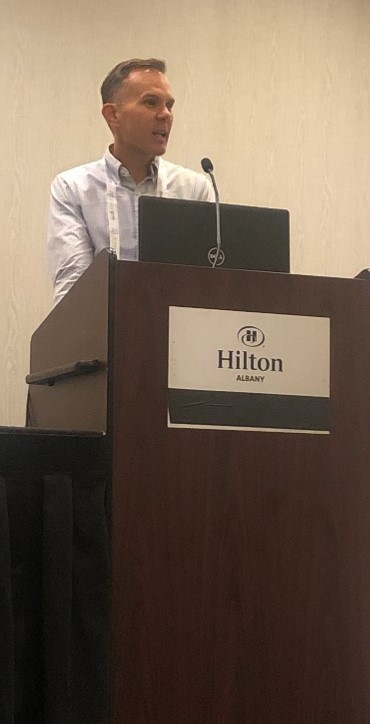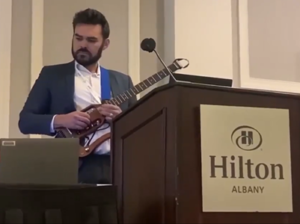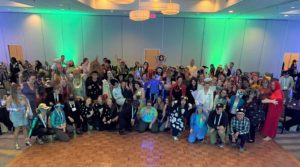This past October, students, scientists, and industry professionals traveled to Albany, New York to kick off the 11th U.S. Symposium on Harmful Algae.
The six-day conference operated under the theme “Science to Support Solutions from Shore to Shore,” to recognize that harmful algal blooms (HABs) present a nationwide challenge that impacts a variety of ecosystems. New York was uniquely suited to host this event, being the only state with both Great Lake and marine coastlines.
More than 450 participants from across the country attended the event. The registrants, who included representatives from the government, private sector, academia, and other organizations, had the opportunity to attend panels, poster sessions, and social events to discuss the effects they are seeing from HABs and potential solutions to the problem.

The symposium provided a platform for participants to share their research related to HABs. Some of the panels were hosted by seasoned professionals with 20 years of experience in the field; others featured students presenting at their very first conference.
The mornings began with a welcome ceremony featuring guest speakers, including Susan Sullivan, executive director of NEIWPCC, who greeted the crowd and talked about NEIWPCC’s role in the clean water industry; and Kathy Sheehan, mayor of Albany, who spoke about how pleased she was to have Albany host the event. New York State Department of Environmental Conservation Commissioner (NYSDEC) Basil Seggos, who is also a NEIWPCC executive committee member, discussed several strategies New York is implementing to prevent HABs.

On Monday morning, the welcome ceremony was followed by a plenary session given by renowned HABs expert Dr. Christopher Gobler, who is an endowed chair and professor within the School of Marine and Atmospheric Sciences at Stony Brook University. Gobler gave a talk entitled “Macrophytes and Harmful Algal Blooms: Protagonists, Antagonists, or Synonymous?” where he explained the complex relationship between macrophytes — or aquatic plants — and algal blooms. He discussed how some research suggests that macrophytes can be cultivated and harvested to prevent HABs from forming. In other cases, macrophytes have harmed other aquatic plants and even created new blooms. Gobler reviewed these various interactions with participants and highlighted the actions New York has taken to prevent and control blooms.
The welcome ceremonies and plenary sessions were followed by various breakout panels, which were categorized by theme to allow registrants to attend sessions based on their interests. More than 150 presentations were given over the course of the symposium. The most common topics from these talks included public health implications, bloom control and mitigation efforts, impacts on animals and food webs, and public education.
A breakout panel about public health featured seven presenters who spoke about the various research that is underway to monitor the impact of algal blooms on human health. One speaker gave an overview of a study comparing bloom presence data to the records of respiratory-related healthcare visits from a Wisconsin hospital, located in proximity to three lakes. Another presentation examined evidence connecting samples of the organic compound alkane, taken from a bloom site, to human dermatological reactions. The session ended with a case study examining an incident where an individual who consumed fish contaminated by harmful algae became ill.

Not all the panelists presented their work in the same way — Thayne Yazzie of Northwest Indian College, located in Bellingham, Washington, gave a live performance on his guitar to demonstrate how he uses the power of music to teach his students about the food web. He started off with a simple bass line (representing plants) and added on musical melodies little by little, until he eventually ended with a higher-pitched riff representing the swooping of a hawk as it looks for a meal. The composed piece, which played out of the speakers at the end of the performance, represented the interconnectivity and complexity of the food web. Yazzie, who is the STEM (Science, Technology, Engineering, Math) education outreach coordinator at the college’s Salish Sea Research Center, is a member of the Dine’/Navajo Nation and uses place-based indigenous knowledge to educate the community about the ecosystem, including how HABs present risks to the safe harvest of seafood and shellfish.
The symposium schedule also included two poster sessions, which gave students and young professionals the opportunity to present their research. These sessions allowed the 140 presenters to share a more in-depth look at their research and processes; they also got to make connections with experts in the field as hundreds of conference participants turned up to view the posters.
Career opportunities and staffing shortages were also at the forefront of the symposium. Many of the speakers emphasized job openings and the need for dedicated staff. The conference lobby also had a job board posted and job seekers had the opportunity to speak directly with industries about their open positions.

Registrants had the option to participate in many social events throughout the conference, including a trivia night and a Halloween-themed dance party, where awards were given out for the best costumes. The nearby New York State Capitol building also offered a haunted tour of the facility for conference participants.
The symposium was hosted by NEIWPCC in partnership with NYSDEC and the U.S. Geological Survey (USGS); additional support was provided by the U.S. National Office for Harmful Algal Blooms at the Woods Hole Oceanographic Institution (WHOI), along with many other program sponsors. For more information about NEIWPCC’s involvement with harmful algal blooms, contact Maryann Dugan at mdugan@neiwpcc.org.